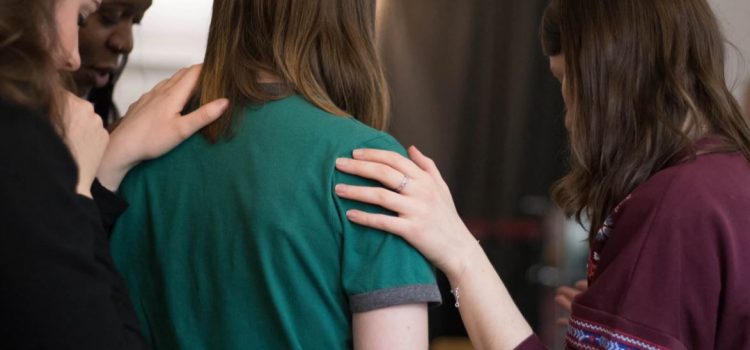

This article is an excerpt from the Shortform book guide to "What Happened to You?" by Bruce Perry and Oprah Winfrey. Shortform has the world's best summaries and analyses of books you should be reading.
Like this article? Sign up for a free trial here .
Are you or someone you know trying to heal from childhood trauma? What actions can you take to help ease your emotional pain?
There is no one-size-fits-all solution to trauma. However, there are pieces of advice that anyone struggling with childhood trauma can follow: Lean on your community, ease your stress response in small doses, and have compassion for yourself and others.
Below, we will go over each piece of advice in detail.
The Healing Process
Healing from childhood trauma is never easy. Trauma can have short-term and long-term impacts on our worldview, behavior, and relationships. Fortunately, there are ways of addressing and working through trauma to help us heal and develop healthy relationships.
Perry and Winfrey maintain that every person going through trauma has a different background and different needs. There is no one-size-fits-all solution to trauma.
(Shortform note: While doctors agree that there is no one-size-fits-all care plan for trauma, there are common guidelines that care providers can follow. For example, the National Child Traumatic Stress Network uses the Psychological First Aid model, which outlines several “core actions” that doctors should perform. These include speaking to the patient with compassion and understanding, stabilizing symptoms, connecting the patient to support networks, and offering practical assistance to the patient and their family. While the details of each case will be different, these “core actions” help doctors make sure that they’re providing positive care.)
Still, the authors mention several important pieces of advice for anyone struggling with trauma: Lean on your community, ease your stress response in small doses, and have compassion for yourself and others. Let’s explore each strategy in detail.
1) Lean on Your Community
According to Perry and Winfrey, the most important factor in dealing with trauma is experiencing love and support from your community. They note that even for people without trauma, having meaningful social connections is an excellent indicator of mental health.
However, when healing from trauma, the authors maintain that these social connections become even more important. To process traumatic events, survivors need to share their thoughts and feelings with a supportive community. Trauma often makes its victims feel unloved and unworthy. But healthy, communicative relationships can help people feel listened to, cared for, and validated.
(Shortform note: While healthy, meaningful connections improve our mental health and can help trauma survivors heal, unhealthy relationships can make people feel unsafe and unloved. So, how can you tell whether your relationships are healthy? Mutual respect, trust, honesty, and compassion are just a few key elements of a healthy relationship. When developing a connection with someone, think about whether you feel safe with them and can be yourself.)
Perry and Winfrey suggest that ideally, a therapist can be a part of this community. But they also note that not everyone has access to a therapist, and Perry maintains that a supportive community of family and friends can be just as valuable.
| Cost-Effective Trauma Care Resources As Perry and Winfrey note, not everyone has the resources to get help from a therapist. Moreover, while family and friends can sometimes support trauma recovery, in other cases, they can actively hinder it. In The Body Keeps the Score, van der Kolk maintains that many people don’t know how to respond when someone shares their trauma. Nonprofessionals might not want to listen, or they might react in a way that causes further harm, such as not believing the survivor’s story. Fortunately, there are many free or low-cost ways to get help with trauma. Here are some services dedicated to providing high-quality and affordable care: -In the US, the Rape, Abuse, and Incest National Network (RAINN) is an organization devoted to helping victims of sexual violence. They operate the national sexual violence hotline, which can be reached at +1 (800) 656-HOPE. Their website also has a live chat feature and information on sexual assault prevention and awareness. -Organizations such as Open Counseling can help you find affordable therapy near you. On Open Counseling’s website, you can find therapists by state, verify that they’re licensed, and see if you qualify for state-funded therapy. -Adult Survivors of Child Abuse is an international organization that helps adults who suffered childhood trauma find therapy and get the care and support networks that they need. |
2) Ease Your Stress Response in Small Doses
As we mentioned earlier, trauma creates associations in the brain that can retrigger the stress response even years after the event. When this happens, it becomes difficult or impossible to think rationally. According to Perry and Winfrey, this makes it hard to work through trauma.
(Shortform note: In The Body Keeps the Score, van der Kolk elaborates on the authors’ point that flashbacks make it hard to work through trauma by noting that flashbacks often shut down specific areas of the brain: in particular, those related to speech and language. This can make it impossible for the trauma survivor to speak about her experience. To combat this, van der Kolk suggests several strategies that can help the victim express and process their trauma, including free-association writing and developing bodily awareness through meditation.)
Therefore, according to the authors, the first step in working through trauma is to ease your stress response. This retrains the brain’s neural pathways to recognize that it isn’t actually in danger, allowing you to think rationally and process traumatic memories. Perry and Winfrey offer two concrete tips for beginning this process:
1) Use rhythm: Rhythmic activities such as walking, dancing, and coloring can help regulate the body and brain when processing traumatic memories. According to Perry and Winfrey, rhythmic motions have a therapeutic effect on us, a connection that goes back to the womb, when we hear our mother’s heartbeat and associate it with safety.
(Shortform note: While Perry and Winfrey claim that rhythm is therapeutic because it connects us to our time in the womb, another theory suggests that rhythm is beneficial because it can change our brainwaves. Scientists have found that listening to rhythmic music causes our brainwaves to resonate with the rhythm. This increases blood flow and activity in the brain, which can improve concentration and reduce anxiety.)
2) Address trauma little by little: Perry suggests that on a biological level, we can’t think or talk about a traumatic memory for more than a few seconds before our brain tries to protect us and our stress response kicks in. Because of this, Perry and Winfrey recommend addressing trauma in small doses. Thinking about a traumatic memory for only a few seconds (as opposed to forcing yourself to think about it for longer) will make it easier to regulate your stress response.
The need to process trauma bit by bit also helps explain why having a large, healthy, and robust community is so important. According to the authors, having a long conversation with one person won’t be as helpful as having many shorter conversations with different people.
| The Body Keeps the Score: Advice on How to Ease the Stress Response The authors’ advice on easing the stress response complements van der Kolk’s advice in The Body Keeps the Score. Like Perry and Winfrey, van der Kolk recommends using rhythm in the healing process. He extends the authors’ point by recommending pairing rhythmic activities with deep breathing (for example, while practicing yoga) to help with regulation and centering. Furthermore, while van der Kolk doesn’t explicitly mention healing in small doses, he does maintain that trauma treatments shouldn’t seek to overwhelm the patient. This is why he argues against Cognitive Behavioral Therapy (CBT). CBT addresses trauma by exposing trauma survivors to triggers for extended periods of time, in an attempt to desensitize the patient. Van der Kolk believes that this overtaxes the body’s stress response and could make the patient more susceptible to flashbacks. Lastly, van der Kolk agrees with Perry and Winfrey on the importance of engaging with a broad community of people. He notes that trauma can make survivors feel alone and out of sync with others, and having a strong community can help reestablish a sense of connectedness. In particular, he recommends pairing community with physical movement. Group activities such as exercise classes can make trauma survivors feel physically in sync with others, providing a sense of connection. |
3) Have Compassion for Yourself and Others
According to Perry and Winfrey, another important element of healing from trauma is having compassion. When a person experiences trauma, they can often feel like something is wrong with them. They might feel that it’s their fault that they can’t sustain a healthy relationship or that seemingly random triggers create anxiety or dissociation. However, Perry and Winfrey emphasize that having trauma doesn’t mean that something is wrong with you.
This is where the title of the book comes from. Instead of asking ourselves and others “What’s wrong with you?”, Perry and Winfrey say, we should ask, “What happened to you?” This question, which they borrow from the work of psychiatrist Sandra Bloom, shifts the focus from blaming the trauma survivor to understanding their past. It introduces compassion into the healing process and helps the survivor understand that it isn’t their fault.
| Sandra Bloom and “What Happened to You?” Sandra Bloom is an internationally renowned psychiatrist and author. In her work, she advocates for communication and compassion in trauma care, particularly in institutions such as schools and hospitals. Bloom’s philosophy of asking “What happened to you?” grew out of this work. She explains that well into the 20th century, doctors sent trauma survivors to large institutions that didn’t treat the underlying causes of trauma or offer personalized care. Instead, these institutions saw trauma survivors as dangerous and focused on keeping them away from the rest of society. Bloom began her work to change the stigma around trauma in the 1970s, inspired by the work of Quaker trauma care centers. These centers, which began in the 19th century, emphasized “moral treatment,” and they created a peaceful community in which trauma survivors could heal. Bloom drew on this theory to develop her own care plans and shift the focus to “What happened to you?” instead of “What’s wrong with you?” While people like Bloom are working to reform trauma care, the stigma that trauma survivors are dangerous and should be removed from society continues today. For example, stereotypes depict trauma survivors as “crazy” or as a danger to themselves and to others. These stereotypes and stigmas can make trauma survivors feel like there is something wrong with them, leading to the shame and guilt that Perry and Winfrey mention. |
| The Body Keeps the Score: Other Treatments for Trauma While van der Kolk agrees with Perry and Winfrey on the importance of community, regulation, and compassion in treating trauma, he also refers to several other treatments that Perry and Winfrey don’t mention. These include: Internal Family Systems Therapy (IFS): This method of therapy is based on the idea that everyone has different “parts,” or aspects, of their personality—one part of you is more closed-off and private, while another is more childlike and joyful. Together, these parts form an internal “family,” each with different needs. The theory of IFS is that trauma disrupts the balance of these different parts, causing some to do more work and others to be locked away. For example, a traumatic event may cause you to be more closed-off to protect yourself from reliving traumatic memories. The closed-off part of your personality therefore takes over, while the childlike, joyful side is hard to access. IFS uses mindfulness and talk therapy to reconcile the different parts of the “family.” This allows the trauma survivor to access all the different parts of her personality, leading to a healthy, whole self. Using touch as a way of healing: Touch therapy includes massage, hugs, and rocking. This method helps patients become more aware of the sensations in their bodies, including pressure points and tension. It then releases these tensions, helping patients become more comfortable and relieving physical symptoms of trauma. |

———End of Preview———
Like what you just read? Read the rest of the world's best book summary and analysis of Bruce Perry and Oprah Winfrey's "What Happened to You?" at Shortform .
Here's what you'll find in our full What Happened to You? summary :
- How childhood trauma can have a severe and lasting impact on the brain
- Why it’s so important to address your trauma
- How to heal from trauma and develop healthy relationships






